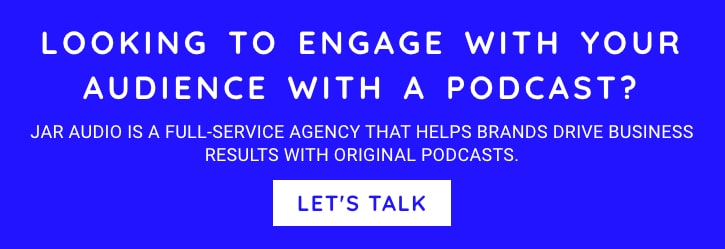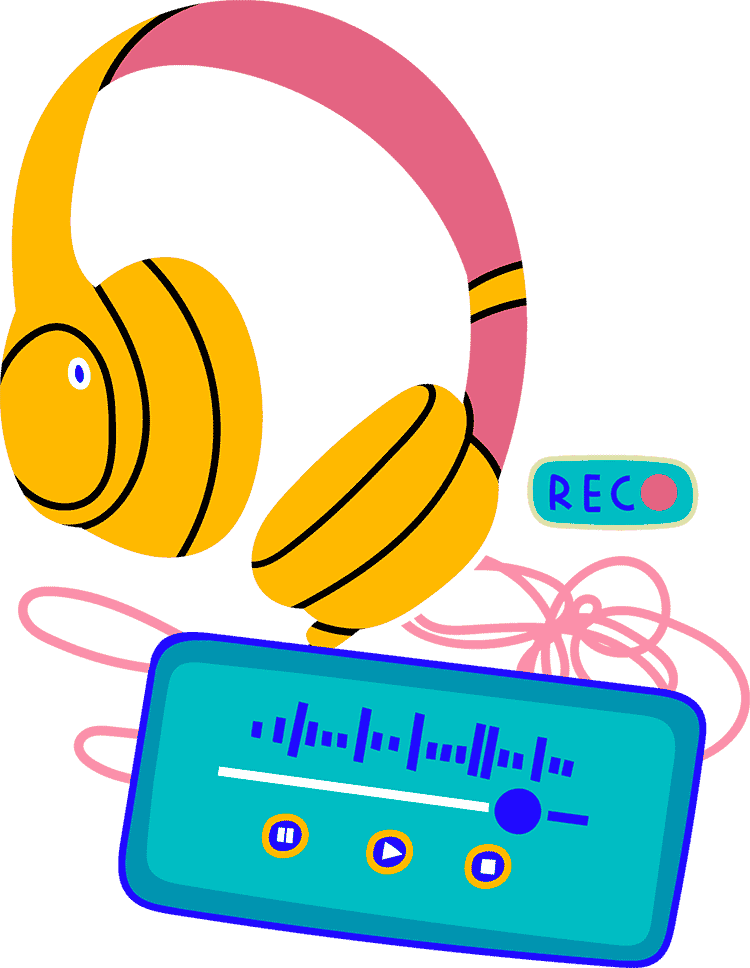How today’s strategic marketers leverage spoken audio.
It pretty much goes without saying that when it comes to effective, full-spectrum marketing, a multimedia approach is the only way to go.
Was there a time when growing brands could rely exclusively on print ads and word of mouth? Sure, but those days are over.
Today’s market is more competitive than ever, and thanks to modern innovations like smartphones and the internet, your reach is more-or-less uncapped.
That said, the exact same terms apply to your competitors. (An unfortunate truth.)
So, while your potential for growth is more than likely at an all-time high, you’ll have to go to much greater lengths to actually stand out…
And if you’re part of a team that’s strategic and proactive, you’re probably already considering the world of spoken audio.
In this post, we explore your options — podcasting and radio — to determine which medium is better for community building, lasting relationships, and long-term growth.

A look at the stats
When you think of talk audio, you probably think of smartphones — not the AM/FM radios many of us grew up with. This makes perfect sense based on the latest data.
Edison Research explored device ownership in the 2022 edition of The Infinite Dial.
In a survey of US residents over the age of 11, this is what they found…
-
88% have at least one smartphone
-
53% own a tablet
-
35% have a smart speaker
-
And only 61% own a radio
Bottom line? Smartphones are ubiquitous, and the overwhelming majority of us have at least one “intelligent” device…
But does this mean radio is a thing of the past? Not at all.
Radio is certainly still kicking, just as the data above suggests — but we should take a look at content consumption, not just device ownership, to get a better handle on this.
A 2021 report from NPR and Edison Research shines a pretty bright light on this topic.
Here are the numbers for folks in the US aged 13 and up…
-
48% of the spoken audio we consume today comes from AM/FM Radio
-
And 22% comes from podcasts
At first glance, this doesn’t make the best case for corporate podcast production, but this isn’t the whole picture, so stick with us.
The long-term trends tell a bit of a different story.
In 2014, here’s what the numbers looked like…
-
79% of spoken audio consumption came from AM/FM radio
-
And just 8% came from podcasts
While this transition is certainly gradual, it’s clear that the podcast is on a long-term rise, and it appears to be edging radio out.
But all of these numbers aside, we’d like to bring something else to the table — and this might just be the most important part of the podcast-versus-radio debate….
This really isn’t an apples-to-apples comparison.
Radio is still widely consumed, yes. It’s also still outperforming the podcast when we look at the broad strokes…
But this really doesn’t mean it’s the only, or most effective way to connect with your ideal audience.
Remember, for truly strategic marketers, it is the quality (not quantity) of relationships that should come first.
And on that note, let’s take a look at what the podcast offers — and where radio tends to fall short.

Prequalify with precision
Can you place ads (or other paid and collaborative content) on AM/FM radio? Sure, but here’s the thing…
With radio, you’re generally looking at an audience that is loosely targeted at best. With a podcast, on the other hand, you have the opportunity to be incredibly precise.
When you have an audience that’s owned (and not borrowed) you have more power in terms of the type of listeners you attract — and you want those listeners to be the kind of people that will really resonate with your brand.
That’s how you’ll get every last drop of value out of your marketing content.
With radio, you might reach a broader audience but you need to be asking yourself how many of these people will actually care what you have to say, let alone emotionally or intellectually invest in it.

Offer real value, foster long-term growth
Ultimately, when it comes to content marketing, you really want your audience to be choosing your content based on their needs, values, and interests.
With a corporate podcast production, you’re not hijacking their “regularly scheduled” content, you become it.
Your listeners choose your professionally crafted series from a list of more than 2 million other shows because you’ve found a niche they truly care about.
It’s important to understand the kind of impression this leaves, especially in contrast to radio promos which they generally haven’t sought out.
With a great branded podcast, you’re not so much asking them for their attention as you are attracting it.
Clearly, this makes a massive impact on…
-
How folks perceive your brand
-
The depth of your relationship with your listeners
-
And the feeling of reciprocity between your brand and your audience
No matter the context, the most meaningful relationships grow from the spirit of generosity — a difficult thing to foster with an ad-based approach.
Give them something great. Ask nothing in return. Watch as loyalty, connection, and audience investment grow.

Maximum scope, maximum value
And while we’re on the topic of value, we should also consider the scope of a podcast — especially as it compares to AM/FM radio.
The branded shows we create usually feature episodes that are around 30 minutes to an hour in length, and many of them run for several seasons…
So the sky really is the limit when it comes to the value you offer.
With great storytelling, expert guests, and exceptional quality, you can bring your audience something that has the power to transform not just their day or their hour, but their lives as a whole.
Ultimately, a corporate podcast comes with the time and space to create something much bigger than what you can offer through almost any other medium — not just radio.

Editing, tone, and creative control
When it comes to the branded podcast, we’d be doing your team a disservice if we didn’t touch on editing, tone, and creative control.
When you’re creating a product that’s entirely your own, every decision around your series is between your brand and the production team you’ve chosen.
This is a huge advantage for teams that are meticulous about branding, identity, ethos, and tone.
What’s more, the podcast format feels more human than radio ads, and comes with less pressure (and more control) than a one-off interview or third-party promo.
By creating content that’s entirely your own, you have the power to shape your brand identity, foster the perfect tone, and leave anything you want on the cutting room floor.
If you’d like to expand on what you’ve learned from this post, you can dive into the topics below…
Subscribe to our newsletter!
Join 1500+ readers and get The Own Your Audience Newsletter right to your inbox.
hbspt.forms.create({
region: “na1”,
portalId: “5753226”,
formId: “d9917e41-8ae4-4ece-a916-b94f66a39ae6”
});


